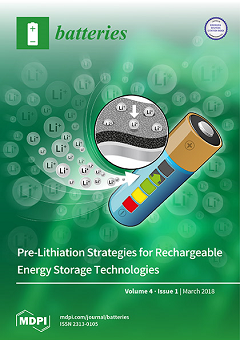Promising electrochemical and dynamical properties, as well as high thermal stability, have been the driving forces behind application of ionic liquids (ILs) and polymerized ionic liquids (PILs) as electrolytes for high-temperature lithium-ion batteries (HT-LIBs). Here, several ternary lithium-salt/IL/PIL electrolytes (PIL
el) have been investigated for synergies of having both FSI and TFSI anions present, primarily in terms of physico-chemical properties, for unique application in HT-LIBs operating at 80 °C. All of the electrolytes tested have low T
g and are thermally stable ≥100 °C, and with TFSI as the exclusive anion the electrolytes (set A) have higher thermal stabilities ≥125 °C. Ionic conductivities are in the range of 1 mS/cm at 100 °C and slightly higher for set A PIL
el, which, however, have lower oxidation stabilities than set B PIL
el with both FSI and TFSI anions present: 3.4–3.7 V vs. 4.2 V. The evolution of the interfacial resistance increases for all PIL
el during the first 40 h, but are much lower for set B PIL
el and generally decrease with increasing Li-salt content. The higher interfacial resistances only influence the cycling performance at high C-rates (1 C), where set B PIL
el with high Li-salt content performs better, while the discharge capacities at the 0.1 C rate are comparable. Long-term cycling at 0.5 C, however, shows stable discharge capacities for 100 cycles, with the exception of the set B PIL
el with high Li-salt content. Altogether, the presence of both FSI and TFSI anions in the PIL
el results in lower ionic conductivities and decreased thermal stabilities, but also higher oxidation stabilities and reduced interfacial resistances and, in total, result in an improved rate capability, but compromised long-term capacity retention. Overall, these electrolytes open for novel designs of HT-LIBs.
Full article





